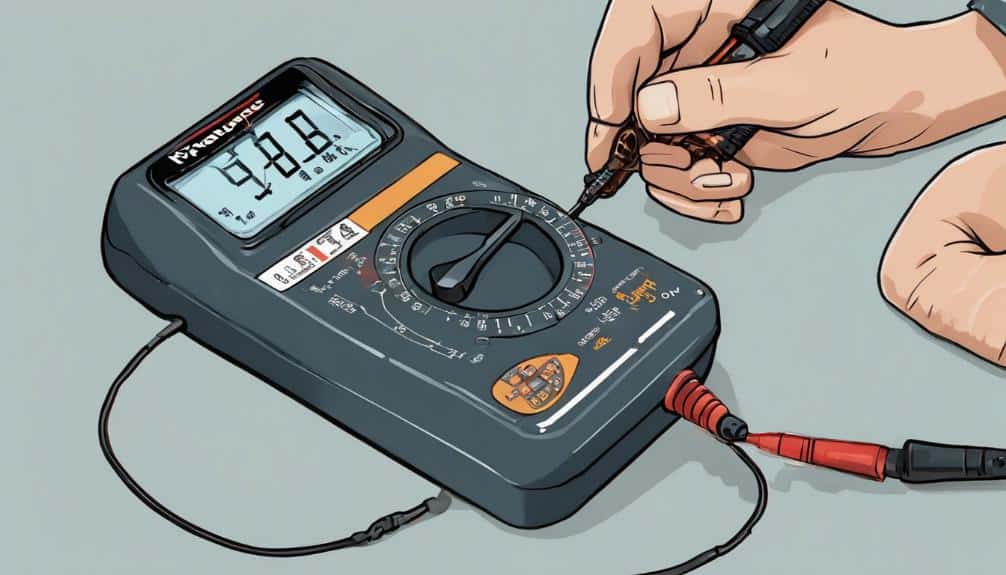To address the P0155 error code concerning the oxygen sensor heater circuit malfunction, you must approach it with a systematic mindset.
Understanding the intricacies of the diagnostic process and how to interpret the results is vital in resolving this issue effectively.
By exploring the various testing methods available and considering the factors that could contribute to the malfunction, you can start unraveling the mystery behind the error code.
Key Points
- Conduct resistance testing to pinpoint issues in the oxygen sensor heater circuit.
- Verify at least 10.5 volts across specific pins using a digital multimeter.
- Utilize the swapping bank connections method to isolate the malfunction source.
- Check wiring power and continuity for optimal heater circuit function.
- Use a multimeter for accurate voltage testing and heater element resistance measurement.
Diagnostic Procedures for P0155

If you frequently encounter the P0155 code, it’s important to conduct diagnostic procedures to pinpoint the issue efficiently.
To begin, resistance testing is a vital step in identifying potential problems within the oxygen sensor heater circuit.
By measuring the resistance in the sensor and related components, you can determine if there are any irregularities causing the P0155 code to trigger.
Also, voltage measurement is another key aspect of the diagnostic process. Checking the voltage supplied to the oxygen sensor heater can reveal issues such as wiring faults or a malfunctioning sensor.
By systematically performing these tests, you can narrow down the root cause of the P0155 code and proceed with the necessary repairs.
Testing Oxygen Sensor Heater Circuit
When testing the oxygen sensor heater circuit, make sure to use a digital multimeter to verify the presence of at least 10.5 volts across specific pins.
This voltage measurement is important as it indicates whether the power supply to the O2 sensor heater is within the expected range for proper functionality.
Also, it’s essential to measure the heater resistance to confirm its integrity within the circuit.
Checking the resistance helps ensure that the heater element is functioning correctly and can provide the necessary heat for the sensor to operate efficiently.
By conducting these tests and referring to pin point tests and circuit diagrams from the service manual, you can effectively diagnose potential issues in the heater circuit.
Keep in mind that examining the circuit for short circuits, open circuits, or fuse problems is also vital in identifying and resolving any faults that may be affecting the oxygen sensor heater’s performance.
What Are the Common Solutions for Oxygen Sensor Heater Circuit Malfunction Codes?
When dealing with fixing the ho2s heater circuit malfunction, there are common solutions to consider. These include checking for damaged wiring or connections, replacing the oxygen sensor, and addressing any issues with the vehicle’s powertrain control module. Additionally, ensuring proper installation and use of the correct sensor can help resolve the problem.
Swapping Bank Connections Method

Consider utilizing the swapping bank connections method as a diagnostic technique to isolate the source of the oxygen sensor heater circuit malfunction.
By swapping the oxygen sensor connections between Bank 1 and Bank 2, you can determine if the issue lies with the sensor or the circuit.
This method aids in engine performance analysis by observing changes in the error code, helping pinpoint which side of the engine is experiencing the malfunction.
Swapping connections can reveal if the problem follows the sensor or remains on the same side, assisting in identifying the problematic component for targeted repair or replacement.
This technique falls under sensor troubleshooting techniques and automotive electrical diagnostics, providing a systematic approach to heater circuit repair strategies.
Implementing the swapping bank connections method is a practical step in the diagnostic process, aiding in the efficient resolution of the oxygen sensor heater circuit malfunction.
Checking Wiring Power and Continuity
To proceed with diagnosing the oxygen sensor heater circuit malfunction, start by checking the wiring power and continuity for optimal performance.
Voltage measurements play a vital role in this process. Confirm that there’s at least 10.5 volts across specific pins of the oxygen sensor heater circuit to ensure proper power supply.
Wiring inspection is equally important; continuity in the connections is essential for the heater circuit to function efficiently.
Look out for any short circuits to ground in the wiring, as these can cause issues and trigger the P0155 code.
Identifying and addressing any wiring problems related to power and continuity is key to resolving this malfunction.
By carefully examining the wiring and conducting voltage measurements, you can pinpoint any issues affecting the oxygen sensor heater circuit. This detailed approach will help in diagnosing and rectifying the P0155 error code effectively.
Utilizing Multimeter for Testing

Using a digital multimeter is crucial for accurately testing the voltage in the oxygen sensor heater circuit.
When troubleshooting with a multimeter, make sure there’s a minimum of 10.5 volts across specific pins in the sensor circuit to guarantee proper functioning.
Verify the power supply to the O2 sensor heater to confirm it’s delivering the required voltage.
To identify potential issues, test for shorts to ground in the heater pins by using the multimeter’s continuity function.
Furthermore, measure the resistance of the heater element to assess its condition accurately.
When conducting voltage measurements, remember to set the multimeter to the appropriate range and always follow safety precautions.
By utilizing multimeter troubleshooting techniques and voltage measurement tips, you can efficiently diagnose and address any concerns within the oxygen sensor heater circuit.
As an Amazon Associate we earn from qualifying purchases.










